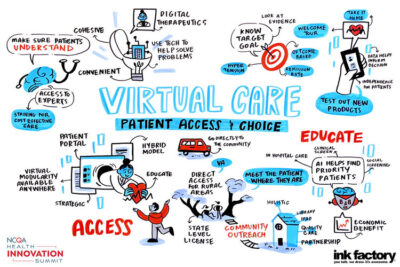Health Quality Forum, Day 1 Wrap Up: Virtual Care, Rural Access and More
April 8, 2025 · Becky Kolinski
NCQA’s Health Quality Forum continues in Baltimore, MD, with health care innovators and thought leaders convening to discuss current topics: virtual care, rural access, birth equity and improving services for people with disabilities. So far, we’re hearing one theme loud and clear: We must continue to engage in collaborative dialogue and build partnerships among health plans, care delivery organizations, clinicians and the community.
Here are some highlights and key takeaways from the forum’s first day.
Birth Equity Accountability Through Measurement Project
Improving maternal and infant health outcomes is a priority for health care organizations, but many struggle to address community-specific needs and overcome systemic barriers. A panel of experts shared experiences and strategies for tackling these challenges.
Key Takeaways
- When measuring birth equity, we need to push for change in areas of misalignment.
- Behind each data curve is a story. To break down silos and create sustainable change, we need to expand our understanding of the data.
- Effective measurement must look at the quantity and quality of our efforts, and whether people are truly better off as a result.
- We all share responsibility for outcomes, and we need to ensure that our work aligns.
Leveraging Virtual Care to Tackle Rural Health Disparities
Rural communities face limited provider access, higher rates of chronic disease and geographic barriers to care delivery. We learned how digital tools like virtual care can transform care delivery and improve health outcomes.
Key Takeaways
- 20% of the U.S. population lives in rural communities, but only 11% of providers practice there.
- Telehealth is a lifeline. It might not always save money for care delivery organizations, but it can reduce patient burden (e.g., time away from work, travel time to receive care.)
- Telehealth can enable multidisciplinary care and improve collaboration, but we must overcome clinician reluctance to adopt it, patient hesitancy and uncertainty about regulations and reimbursement.
- Broadband access and digital literacy are barriers. Care delivery organizations need to set up patients for success with training and access to digital tools.
- Clinician partnerships are vital—offering help is not stealing patients, it’s collaborating on care.
Expanding Access to Virtual Care
Virtual care connects patients to providers—when and where they are needed. Our panel of virtual care organizations shared real-world lessons on scaling virtual care to reach underserved populations.
Key Takeaways
- Investment in community-based virtual care will yield long-term economic benefits.
- Virtual care is not a standalone solution, but it can fill gaps—especially if the alternative is no care—and should be integrated into broader systems.
- Focus on bringing virtual care to patients where they are—homes, libraries, community centers—and partner with community organizations to improve access for people without technology at home.
- Patient-generated health data can help identify trends and encourage involvement of care teams.
- Don’t assume patients know how to use technology! Invest in onboarding patients to virtual platforms, and test new technology before introducing it.
- Normalizing virtual care—and telling patients how their data are used—makes it easier for patients to adopt it.
Creating Accessible Systems of Care for People with Disabilities
Ensuring equitable care for people with disabilities requires intentional data collection, inclusive care models and removal of systemic barriers. Our presenters shared thoughts on creating inclusive health systems that support people with disabilities.
Key Takeaways
- 33% of the Medicaid population self-reports having a disability, but only 11% qualify for Medicaid under the program’s definition of disability.
- Most patients feel comfortable disclosing disability status to their care team, but health systems struggle to implement standardized data collection.
- It’s important to document any accommodation needs along with a patient’s disability status. Health care organizations must provide accommodations at no additional cost to the patient.
- Developing standard definitions and educating clinicians can help reduce bias and make them more comfortable discussing a patient’s disability status.
Learn More
Read more updates from the Health Quality Forum:
- Health Quality Forum Opening Remarks: “We Must Raise Our Ambitions”
- Health Quality Forum, Day 2 Wrap Up: State Innovations, Social Needs Data and Reducing Disparities
View and download the visual note boards from the event. Below is a sample.

Real-time Visual Notes created by Ink Factory.








